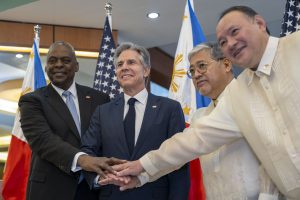The United States has announced $500 million in new military funding for the Philippines, aimed at boosting the country’s external defense capacity at a time of growing friction with China, particularly in the South China Sea.
While the funding was announced by the Department of Defense earlier in the week, it was made official by Secretary of State Antony Blinken and Defense Secretary Lloyd Austin following a 2+2 Ministerial Dialogue with their Philippine counterparts, Enrique Manalo and Gilberto Teodoro.
In a joint news conference yesterday, the four officials said that the $500 million, an amount that Austin described as “unprecedented,” would be used to “boost security collaboration with our oldest treaty ally in this region.” Blinken said the “once-in-a-generation investment” would be used to help modernize both the Armed Forces of the Philippines and the Philippine Coast Guard. The two sides also announced progress on a proposed military intelligence-sharing pact that is intended to allow both sides to exchange more sophisticated military intelligence.
At a meeting with President Ferdinand Marcos Jr., Austin and Blinken “reaffirmed US support for the Philippines in defending its sovereign rights,” and “discussed the importance of preserving the rights of all nations to fly, sail, and operate – safely and responsibly – wherever international law allows,” according to a statement from the U.S. Defense Department. The leaders also discussed the involvement of other “like-minded nations,” like Australia and Japan, “to strengthen shared principles, including the rule of law, freedom of the seas, and respect for territorial sovereignty.”
Philippine Defense Secretary Gilberto Teodoro hailed the infusion of funds, saying that “every peso or dollar spent on hardening Philippine capabilities to defend itself and to deter unlawful aggression will be a plus against any threat actor, whether it be China or anyone.”
The announcement is the latest instance of the deepening defense cooperation between the two allies. Last year, the Marcos administration expanded U.S. access to Philippine military facilities under the Enhanced Defense Cooperation Agreement first signed in 2014. Since late last year, the U.S. has also taken part in joint maritime patrols of the South China Sea.
This cooperation has grown out of shared concerns about China’s growing maritime power and assertive behavior in the South China Sea, particularly in areas of the waterway claimed by the Philippines. In response, Beijing has intensified its pressure campaign against the Philippines in the South China Sea, particularly at Second Thomas Shoal in the Spratly Islands.
“Both of us share concerns and many other countries in the region share concerns, as well, about some of the actions that the People’s Republic of China has taken, escalatory actions in the South China Sea, the East China Sea, and elsewhere,” Blinken said during the news conference. He also made reference to China’s “coercive methods” in contested waters.
The visit came not long after the Philippines and China reached a temporary arrangement to prevent clashes around the Philippine-occupied Second Thomas Shoal and allow Manila to resupply the garrison aboard the BRP Sierra Madre, a grounded warship that serves as its outpost on the shoal. The “provisional” arrangement was negotiated after a violent incident on June 17, in which the China Coast Guard (CCG) blocked a resupply mission to the Sierra Madre, injuring eight Filipino sailors, one seriously.
While Beijing and Manila have come to an arrangement, albeit while disagreeing publicly on the scope of the deal, the underlying dispute remains unresolved and remains a potentially combustive issue in China-Philippines relations. The funding is a strong message from the U.S. government that it will continue to back the Philippines in the South China Sea. While this alone is unlikely to significantly shift the course of Chinese policy, looming behind the funding announcement is the question of whether the U.S. might intervene directly under the terms of the 1951 Mutual Defense Treaty.
Speaking yesterday, Austin said that he and Blinken had “reaffirmed” Washington’s commitment to the terms of the treaty, which oblige it to come to the Philippines’ aid in the event of an “armed attack” on the Philippines or on its “on its armed forces, public vessels, or aircraft in the Pacific.” Austin also repeated the assurance that the Mutual Defense Treaty “applies to armed attacks on either of our armed forces, aircraft, or public vessels anywhere in the South China Sea.”

































